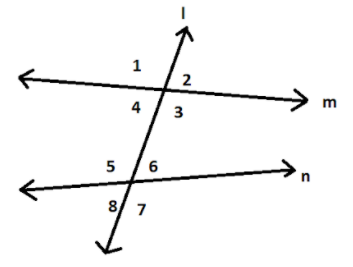
State Euclid’s fifth postulate. Using the same write the pairs of angles, having the sum less than


Answer
498.6k+ views
Hint: Write Euclid’s postulate as it is described by Euclid in the first place. Then use the facts given in the postulate to analyze the figure and find the solution.
Complete step by step solution: Euclid’s fifth postulate:
If a straight line falling on two straight lines makes the interior angles on the same side of it taken together less than two right angles i.e., 180∘, then the two straight lines, if produced indefinitely meet on that side on which sum of angles is less than two right angles.
So, here according to this image it is given, there are two given lines m and n, and the line l is intersecting these two lines.
Now, if we check the right side of the line l, we can see 4 angles, 2, 3, 6 and 7.
So, as per Euclid’s fifth postulate, if produced indefinitely meet on that side on which sum of angles is less than two right angles. So, we get,
Note: The fifth postulate is also known as the Parallel Postulate because it can be used to prove properties of parallel lines.
In a plane, given a line and a point not on the line, there are exactly three possibilities with regard to the number of lines through the point:
1) There is exactly one line parallel to the given line;
2) There is no line parallel to the given line;
3) There is more than one line parallel to the given line.
Complete step by step solution: Euclid’s fifth postulate:
If a straight line falling on two straight lines makes the interior angles on the same side of it taken together less than two right angles i.e., 180∘, then the two straight lines, if produced indefinitely meet on that side on which sum of angles is less than two right angles.
So, here according to this image it is given, there are two given lines m and n, and the line l is intersecting these two lines.
Now, if we check the right side of the line l, we can see 4 angles, 2, 3, 6 and 7.
So, as per Euclid’s fifth postulate, if produced indefinitely meet on that side on which sum of angles is less than two right angles. So, we get,
Note: The fifth postulate is also known as the Parallel Postulate because it can be used to prove properties of parallel lines.
In a plane, given a line and a point not on the line, there are exactly three possibilities with regard to the number of lines through the point:
1) There is exactly one line parallel to the given line;
2) There is no line parallel to the given line;
3) There is more than one line parallel to the given line.
Latest Vedantu courses for you
Grade 9 | CBSE | SCHOOL | English
Vedantu 9 CBSE Pro Course - (2025-26)
School Full course for CBSE students
₹37,300 per year
EMI starts from ₹3,108.34 per month
Recently Updated Pages
Express the following as a fraction and simplify a class 7 maths CBSE

The length and width of a rectangle are in ratio of class 7 maths CBSE

The ratio of the income to the expenditure of a family class 7 maths CBSE

How do you write 025 million in scientific notatio class 7 maths CBSE

How do you convert 295 meters per second to kilometers class 7 maths CBSE

Write the following in Roman numerals 25819 class 7 maths CBSE

Trending doubts
Where did Netaji set up the INA headquarters A Yangon class 10 social studies CBSE

A boat goes 24 km upstream and 28 km downstream in class 10 maths CBSE

Why is there a time difference of about 5 hours between class 10 social science CBSE

The British separated Burma Myanmar from India in 1935 class 10 social science CBSE

The Equation xxx + 2 is Satisfied when x is Equal to Class 10 Maths

What are the public facilities provided by the government? Also explain each facility




